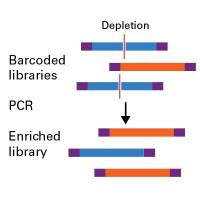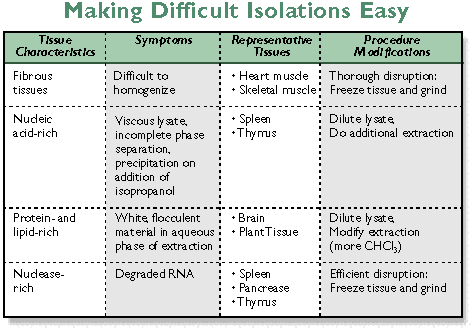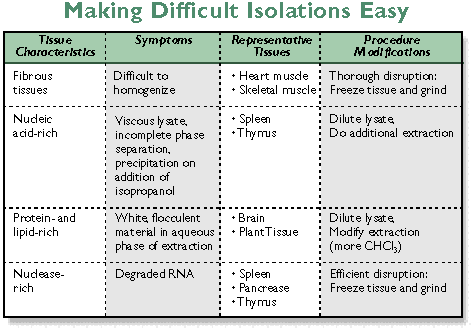Isolation of Total RNA from Difficult Tissues
互联网
The often exacting process of isolating intact total RNA from tissue becomes even more difficult when processing certain problematic tissues. Fibrous tissues and tissues rich in protein, DNA and nucleases present distinct challenges for total RNA isolation. Some of the demanding tissues requiring more manipulation and fine-tuning during the RNA isolation procedure are heart, brain, thymus and spleen. Here we address problems we have encountered, and offer troubleshooting techniques to help overcome problems associated with isolating total RNA from difficult tissues. The tips provided are based on RNA isolation by a guanidinium thiocyanate/acid phenol:chloroform extraction method (e.g. Ambion"s ToTALLY RNA™ Kit). Note that many of these techniques can be used with other RNA isolation protocols as well.
Heart and Skeletal Muscle: Fibrous Tissues
For fibrous tissues such as rat and mouse heart and skeletal muscle, the most difficult step in the isolation process can be complete disruption of all the cells when preparing tissue homogenates. Due to low cell density and the polynucleate nature of muscle tissue, the yield of total RNA is typically low; therefore, making the most of the tissue on hand is critical. Preparation for homogenization should be carried out on dry ice, under liquid nitrogen. Pulverizing the tissue into a powder while keeping the tissue completely frozen is key to isolating intact total RNA. Large chunks of fibrous tissue are difficult to homogenize completely and can result in degraded RNA and very low yield. Unfortunately, the signs of complication occur only at the end of the isolation process, during calculation of yield and visualization of the total RNA on a gel. Therefore, care should be taken during the initial preparation of the homogenate to ensure intact total RNA.
<center> <img height="328" src="http://img.dxycdn.com/trademd/upload/asset/meeting/2013/07/08/A1373252694.gif" width="473" /> </center>Brain and Plant Tissues: Protein and Lipid-rich Tissues
Isolating total RNA from rat or mouse brain can be very rewarding because of the large yields recovered once troubleshooting techniques have been implemented. Brain and plant tissues are rich in lipids, which can complicate the RNA extraction process, making it difficult to get a clean separation of RNA. An obvious sign of trouble occurs once the brain or plant homogenate has been extracted with phenol:chloroform:IAA.











